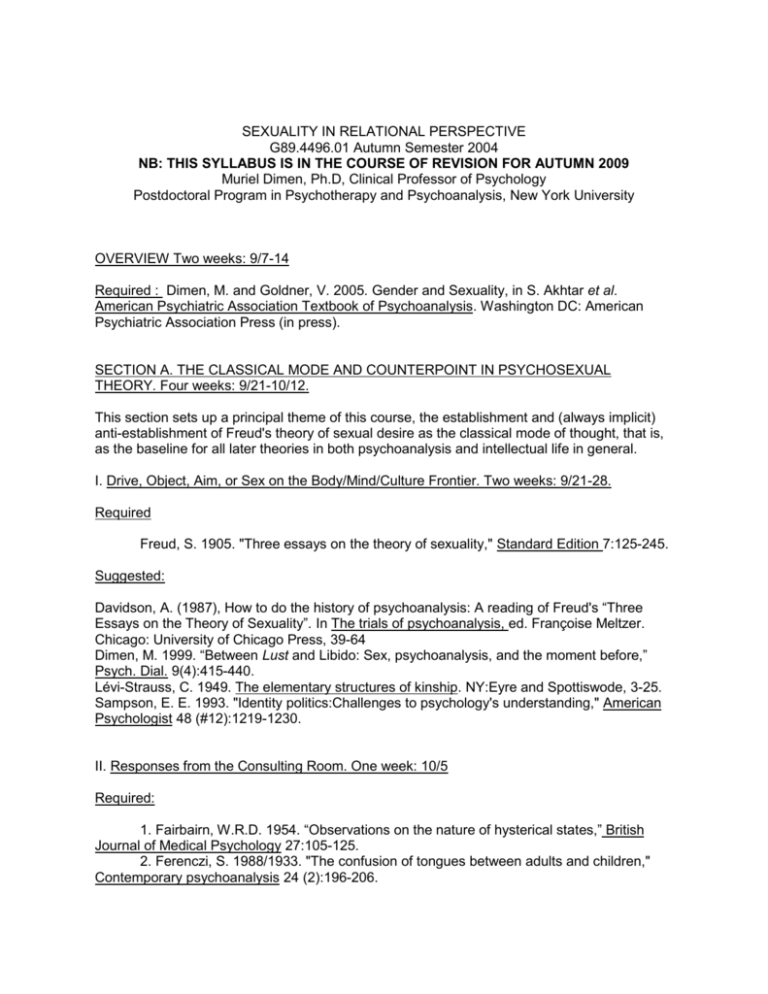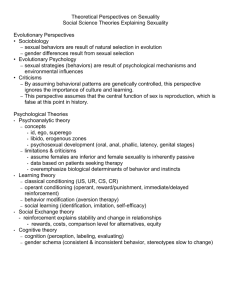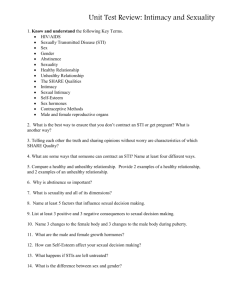
SEXUALITY IN RELATIONAL PERSPECTIVE
G89.4496.01 Autumn Semester 2004
NB: THIS SYLLABUS IS IN THE COURSE OF REVISION FOR AUTUMN 2009
Muriel Dimen, Ph.D, Clinical Professor of Psychology
Postdoctoral Program in Psychotherapy and Psychoanalysis, New York University
OVERVIEW Two weeks: 9/7-14
Required : Dimen, M. and Goldner, V. 2005. Gender and Sexuality, in S. Akhtar et al.
American Psychiatric Association Textbook of Psychoanalysis. Washington DC: American
Psychiatric Association Press (in press).
SECTION A. THE CLASSICAL MODE AND COUNTERPOINT IN PSYCHOSEXUAL
THEORY. Four weeks: 9/21-10/12.
This section sets up a principal theme of this course, the establishment and (always implicit)
anti-establishment of Freud's theory of sexual desire as the classical mode of thought, that is,
as the baseline for all later theories in both psychoanalysis and intellectual life in general.
I. Drive, Object, Aim, or Sex on the Body/Mind/Culture Frontier. Two weeks: 9/21-28.
Required
Freud, S. 1905. "Three essays on the theory of sexuality," Standard Edition 7:125-245.
Suggested:
Davidson, A. (1987), How to do the history of psychoanalysis: A reading of Freud's “Three
Essays on the Theory of Sexuality”. In The trials of psychoanalysis, ed. Françoise Meltzer.
Chicago: University of Chicago Press, 39-64
Dimen, M. 1999. “Between Lust and Libido: Sex, psychoanalysis, and the moment before,”
Psych. Dial. 9(4):415-440.
Lévi-Strauss, C. 1949. The elementary structures of kinship. NY:Eyre and Spottiswode, 3-25.
Sampson, E. E. 1993. "Identity politics:Challenges to psychology's understanding," American
Psychologist 48 (#12):1219-1230.
II. Responses from the Consulting Room. One week: 10/5
Required:
1. Fairbairn, W.R.D. 1954. “Observations on the nature of hysterical states,” British
Journal of Medical Psychology 27:105-125.
2. Ferenczi, S. 1988/1933. "The confusion of tongues between adults and children,"
Contemporary psychoanalysis 24 (2):196-206.
Dimen/Sexuality in Relational Perspective 2003
Page 2
3. Rivera, M. 1989. "Linking the psychological and the social:Feminism,
poststructuralism, and multiple personality," Dissociation 2 (1):24-31.
Suggested:
Klein, G. 1976/1969. “Freud's Two Theories of Sexuality,” Psychological Issues. Vol. 9, #4,
Monograph #36. Also in Psychology vs. Metapsychology: Psychoanalytic Essays in Memory of
George S. Klein, ed. M. Gill and P.S. Kolzman. International Universities Press. 1976, 14-70.
Kohut, H. 1977. The restoration of the self. International Universities Press, Ch 5, “The
Oedipus complex and the psychology of the self,” pp. 220-248.
Lichtenstein, H. 1961. “Identity and Sexuality: The Study of Their Interrelationship in Man.”
Journal of the American Psychoanalytic Association 9:179-260
III. Sexual stages, sexual character. One week: 10/12
Required:
1. Meltzer, D. 1979 [1973]. Sexual states of mind. Perthshire, Scotland:Clunie Press.
Ch. 3, "Developmental phases and organizational series," 21-27 (also summarizes Abraham)
and Ch. 4, "From pain-and-fear to love-and-pain," 28-34.
2. Reich, W. 1972. "The genital character and the neurotic character (The sexeconomic function of the character armor)," in Character analysis. (NY:Touchstone, 169-193),
read excerpt 176-85.
3. Kernberg, O. 1976. "Barriers to falling and remaining in love," in Object relations
theory and clinical psychoanalysis. NY:Aronson, 185-214.
4. Fausto-Sterling, A. 1993. "The five sexes:Why male and female are not enough,"
The Sciences (March/April), 20-24.
Suggested:
Abraham, K. 1927 (1924). "A short study of the development of the libido, viewed in the light of
mental disorders," in Selected papers on psycho-analysis. Jones, E., ed. NY:Brunner/Mazel,
418-501.
Erikson, E. 1963. "The theory of infantile sexuality," in Childhood and society. N.Y.:Norton, 48108, esp. 72-108 (skim).
Reich, W. 1972. "The characterological resolution of the infantile sexual conflict," in Character
analysis. NY:Touchstone, 153-168.
_______. "The development of the orgasm theory," The function of the orgasm
NY:Touchstone, 84-117.
CLINICAL BREATHER: Sexual Transference/Countertransference. One week: 10/19.
1. Gabbard, G. 1994. On love and lust in erotic transference. JAPA 42:385-403.
2. Gornick, L.K. 1986. "Developing a new narrative:The woman therapist and the male
patient," in J. Alpert, ed., Psychoanalysis and women (Hillsdale, NJ:Analytic Press), 257-87.
Dimen/Sexuality in Relational Perspective 2003
Page 3
3. Wrye, H.K. and J.K. Welles. 1989. "The maternal erotic transference," IJP 70:673684.
Suggested:
Bonasia, E. 2001. “The countertransference: Erotic, erotised and perverse,”
IJP 82:249-262.
Person, E. 1980. "The erotic transference in women and men," JAPA 13:159-180.
SECTION B. POSTCLASSICAL READINGS OF DESIRE. Two weeks: 10/26-11/2
This section takes up a variety of revisions -- ego-psychological, relational, and contemporary
Freudian; left and feminist; postmodernist -- on classical themes. Debates include
development and normativity; the gendering of sexuality; sexuality and attachment; power, and
the construction and multiplicity of desire.
IV. Two Views During the “Sexual Revolution: One week: 10/26
Required:
1. Stoller, R.J. 1979. Sexual excitement. N.Y.:Pantheon, 3-36.
2. Person, E. 1980. "Sexuality as the mainstay of identity," Signs 5:605-630.
Suggested:
Goldner, V. 1989. "Sex, power, and gender:The politics of passion," in Kantor, D. and B. F.
Okun, Intimate environments:Sex, intimacy, and gender. N.Y.:The Guilford Press, 28-53.
Kovel, J. 1981. The age of desire. NY:Pantheon. "Desire and the transhistorical," 61-85;
"Desire and praxis," 231-42.
Rubin, G. 1975. "The traffic in women:Notes toward the political economy of sex," in R. Rapp
Reiter, ed., Toward an anthropology of women. NY:Monthly Review Press, 157-210.
V. Psychoanalysis Rapproaches Sex. One week. 11/2
Required:
1. Mitchell, Stephen A. 1988. Relational concepts in psychoanalysis:An integration.
Cambridge:Harvard University Press, Chs. 3 and 4.
2. Green, A. 1996. “Has sexuality anything to do with psychoanalysis?” IJP 76:871883.
3. Stein, R. 1998. “The poignant, the excessive and the enigmatic in sexuality,” IJP
79:253-268.
Suggested:
Bach, S. 1995. The language of perversion and the language of love.
Dimen/Sexuality in Relational Perspective 2003
Page 4
Kernberg, O. 1976. Love Relations:Pathology and Normality. New Haven: Yale University
Press.
Mcdougall, J. 1995. The Many Faces of Eros. NY:Norton.
VI . Postmodern Theories of Desire I: Lacan . One week: 11/19
Required:
1. Mitchell, J. 1982. "Introduction - I," Feminine sexuality:Jacques Lacan and the école
freudienne, J. Mitchell and J. Rose, eds., J, Rose, tr. N.Y.:Pantheon, 1-26.
2. Rose, J. 1982. "Introduction - II," Feminine sexuality:Jacques Lacan and the école
freudienne, J. Mitchell and J. Rose, eds., J. Rose, tr. N.Y.:Pantheon, 27-58.
VII. Postmodern Theories of Desire II: Foucault. One week: 11/16
Required:
1. Foucault, M. 1980. The history of sexuality:Volume I. N.Y.:Vintage Books, 1-75.
2. Laqueur, T. 1990. Making sex:Body and gender from the Greeks to Freud.
Cambridge:Harvard University Press. "Freud's Problems," pp. 233-43.
Suggested:
Butler, J. 1990. Gender trouble:Feminism and the subversion of identity. NY:Routledge, 1-35.
Dimen, M. 1996 "On 'Our Nature':Prolegomenon to a relational theory of sexuality," in R.
Lesser and T. Domenici, eds., Disorienting sexualities. NY:Routledge 129-52.
Flax, J. 1990. Thinking fragments;Psychoanalysis, feminism, and postmodernism in the
contemporary West. Berkelely:Univ. of Calif. Press, Chapter 8, "Postmodernism:Thinking in
fragments," 187-222.
CLINICAL BREATHER. Sexual Countertransference and Self-Disclosure. One week: 11/23
Required:
1. Searles, H. 1965, "Oedipal love in the countertransference," Collected papers on
schizophrenia and related subjects. N.Y.:International Universities Press.: 284-303.
2. Davies, J.M. (1998), “Between the disclosure and foreclosure of erotic transferencecountertransference: Can psychoanalysis find a place for adult sexuality?” Psychoanal. Dial.,
6:747–766.
3. Gabbard, G. 1996. “The analyst’s contribution to the erotic transference,” Contemp.
Psychoanal. 32:249-273.
Suggested:
Tansey, M.J. 1994. "Sexual attraction and phobic dread in the countertransference," Psych.
Dial. 4:139-152.
Dimen/Sexuality in Relational Perspective 2003
Page 5
Hirsch, I. 1994. "Countertransference love and theoretical model," Psych. Dial. 4:171-192.
Benjamin, J. 1994. "Commentary on papers by Tansey, Hirsch, and Davies," Psych. Dial.
4:193-202.
Gabbard, G.O. 1994. "Love and dread in the analyst:Commentary on papers by Tansey,
Hirsch, and Davies," Psych. Dial. 4:203-214.
Davies, J.M. 1994. "Dread and desire in the analyst:Reply to Glen Gabbard's commentary on
'Love in the afternnoon' (PD 4/2)," Psych. Dial. 4:503-508.
Gabbard, G. 1994. "A response to Davies (But not the last word)," Psych. Dial. 4:509-510.
Knoblauch, S. H. 1996. "To speak or not to speak:How and when is that the question?" Psych.
Dial. 5:151-5.
Welles, J.K. and H. Wrye. 1991. "The maternal erotic countertransference," IJP 72:93-106.
SECTION C. CODIFICATIONS OF DESIRE. Three weeks 11/30-12/14.
This section examines the standard constellations of desire -- heterosexual, homosexual,
bisexual and perverse -- as classically codified and then re-interpreted by later psychoanalytic
theorists and cultural critics in the light of desire’s quotidian ambiguities.
VIII. GLB: Deconstructing Homosexualities. One Week. 11/30.
Required:
1. Schuker, E. 1996. “Toward further analytic understanding of lesbian patients.” JAPA
44 (Suppl):485-508.
2. Drescher , J. n.d. From bisexuality and homosexuality to intersexuality:rethinking
gender categories. Unpub. Ms.
3. Lingiardi, V. and P. Capozzi. 2004. Psychoanalytic attitudes towards homosexuality:
An empirical research. IJP 85:137-158.
Suggested Readings on Female Homosexuality:
Butler, J. 1992. "The lesbian phallus and the morphological imaginary," Differences 4:133-171.
Freud, S. 1920. "The psychogenesis of a case of homosexuality in a woman," SE 18:145-172.
Harris, A. 1989. "Gender as contradiction," Psych. Dial.:1 (2):197-224.
Lindenbaum, J. 1985. "The shattering of an illusion:The problem of competition in lesbian
relationships," Feminist Studies 11 (1):85-103.
Magee, M. and D. C. Miller. 1992. "'She foreswore her womanhood': Psychoanalytic views of
female homosexuality," Clinical Social Work Journal 20:67-87.
McDougall, J. 1980. "The homosexual dilemma:A study of female homosexuality," in
McDougall, J., Plea for a measure of abnormality. N.Y.:International Universities Press, 87-140
O'Connor, N. and J. Ryan. 1994. Wild desires and mistaken identities:Lesbianism and
psychoanalysis. NY:Columbia.
Suggested Readings on Male Homosexuality:
Corbett, K. J. 1993. "The mystery of homosexuality," Psychoanal. Psychol. 10:345-358.
Friedman, R. 1988. Male homosexuality. New Haven:Yale University Press. Ch. 1.
Dimen/Sexuality in Relational Perspective 2003
Page 6
Friedman, R. 1986. "The psychoanalytic model of male homosexuality:A historical and
theoretical critique," Psychoanalytic Review 73:79-116.
Freud, S. 1910. "Leonardo da Vinci and a memory of his childhood," SE XI:63-137.
Isay, R.A. 1989. Being homosexual:Gay men and their development. N.Y.:Farrar, Straus,
Giroux, 3-10, 11-46.
Lewes, K. 1989. "Theoretical overview I," in The psychoanalytic theory of male homosexuality.
NY:Simon and Schuster, 69-94.
Mitchell, S.A. 1981. "The psychoanalytic treatment of homosexuality:Some technical
considerations," International Review of Psychoanalysis 8:63-80.
Schwartz, D. 1985. "Current psychoanalytic discourses on sexuality:Tripping over the body." in
R. Lesser and T. Domenici, eds., Disorienting sexualities. NY:Routledge ,115-26.
Suggested readings on bisexuality:
Aron, L. 1996. Aron, L. "The internalized primal scene," Psych. Dial. 5:195-236.
_____ "Reply to David Schwartz," Psych. Dial. 5:249-256.
Freud, S. 1937. "Analysis terminable and interminable," SE XXIII:252.
Kurtz, S.N. 1991. "Polysexualization in the Trobriands," Ethos 9 (#1):68-101.
McDougall, J. 1986. "Eve's reflection:On the homosexual components of female sexuality," In
H. Meyer, Between analyst and patient:New dimensions in transference and
countertransference. NY:Analytic Press, pp. 213-228.
Meltzer, D. 1979 [1973]. "On the distinction ambisexual:bisexual," in Sexual states ..., 114121.
Schwartz, D. 1996. "Retaining classical concepts-hidden costs: Commentary on Lewis Aron's
'The internalized primal scene,'" Psych. Dial. 5:239-248.
Segal, H. 1964. "The early stages of the Oedipal conflict," in Introduction to the work of
Melanie Klein. NY:Basic, 102-116.
Stoller, R.J. (1973) "Facts and fancies:An examination of Freud's concept of bisexuality," In J.
Strouse, ed., Women and analysis N.Y.:Dell, 391-416.
Deconstructing the Hetero/Homo Binary. One week: 12/7
Required:
1. Chodorow, N. 1992. "Heterosexuality as compromise formation," Psychoanalysis
and contemporary thought 15(#3): 267-304.
2. Butler, J. 1996. "Melancholy gender-refused identification," Psych. Dial. 5:165-180.
Suggested:
Butler, J. 1996. "Reply to Adam Phillips," Psych. Dial. 5:189-194.
Chodorow, N. 1978. "Oedipal asymmetries and heterosexual knots," in The reproduction of
mothering:Psychoanalysis and the sociology of gender. Berkeley:University of California
Press, 191-198.
Flax, J. 1990. Thinking fragments;Psychoanalysis, feminism, and postmodernism in the
contemporary West. Berkelely:Univ. of Calif. Press, Chapter 4, "Lacan and Winnicott:Splitting
and regression in psychoanalytic theory," 89-132.
Dimen/Sexuality in Relational Perspective 2003
Page 7
Gallop, J. 1984. The daughter's seduction:Feminism and psychoanalysis. Ithaca:Cornell
University Press, Chs. 1-3.
(on Lacan)
Katz, J. N. 1990. "The invention of heterosexuality," Socialist Review 20 (1):7-34.
Moss, D. 1992. "Introductory thoughts:Hating in the first person plural:The example of
homophobia," American Imago 49:277-292.
Person, E. 1986. "The omniavailable woman and lesbian sex:Two fantasy themes and their
relationship to male developmental experience," in Fogel, G.I., F.M. Lane and R.S. Liebert,
The psychology of men. N.Y.:Basic, 71-94.
Phillips, A. 1996. "Keeping it moving:Commentary on Judith Butler's 'Melancholy genderrefused identification," Psych. Dial. 5:181-188.
Rich, Adrienne, 1980. "Compulsory heterosexuality and lesbian existence," Signs 5(4):631660.
Rubin, G. 1975, "The traffic in women:notes toward a political economy of sex," in R. Rapp,
Toward an anthropology of women, NY:Monthly Review Press, 157-211.
Schwartz, D. 1993. "Heterophilia-- The love that dare not speak its aim:Commentary on Trop
and Stolorow's 'Defense analysis in self psychology:A developmental view,'" Psych. Dial. 3
(4):643-56.
Ussher, J. M. 1993. "The construction of female sexual problems:regulating sex, regulating
woman," in Ussher and Baker, pp. 9-40.
Weeks, J. 1981. "Discourse, desire, and sexual deviance;Some problems in a history of
homosexuality," in K. Plummer, ed., The making of the modern homosexual.
London:Hutchinson, 76-111.
Williams, W. 1989. The spirit and the flesh:Sexual diversity in American Indian culture.
Boston:Beacon, 1-14, 252-276.
XI. Rethinking Perversion. One week: 12/14
Required:
1. Khan, M.M.R. 1979. ”Fetish as Negation of the Self: Clinical Notes on Foreskin
Fetishism in a Male Homosexual.” In: Alienation in Perversions. New York: International
universities Press, 139-176.
2. Ogden, T. 1996. “The perverse subject of analysis,” JAPA 44: 1121-46.
Suggested:
Chasseguet-Smirgel, J. 1985. Creativity and Perversion. NY:Norton.
De Lauretis, T. 1994. The Practice of Love: Lesbian Sexuality and Perverse Desire.
Bloomington:Indiana.
Dimen, M. 2001. “Perversion is Us? Eight Notes,” Psychoanalytic Dialogues
1:325-360.
Freud, S. 1928. “Fetishism,” Standard Edition 1961, 21:152-7.
Fuss, D. 1991. "Inside/Out," in Inside/out:Gay theory, lesbian theory. NY: Routledge, 1-9.
Kaplan, L.J. (1991), Female Perversions. New York: Anchor Books.
Stoller, R.J. 1975. Perversion:The Erotic Form of Hatred. Washington, DC:American
Psychiatric Press.
Dimen/Sexuality in Relational Perspective 2003
Page 8
DISCUSSION QUESTIONS
1. Defining terms: What is sex? or, alternatively, how do we think of sex?
2. Desire: How do you explain sexual orientation? sexual attraction? What are the categories
you use? What's your explanatory and/or rhetorical strategy?
3. Pleasure: "An obstacle is required to heighten libido" (Freud, On the universal tendency to
debasement in the sphere of love, Standard Edition XI:179-190, p. 187).
What turns people on? and off? What do people find exciting? What is sexual excitement?
Does libido need "heightening"? Is there a role for power in sexual excitement, and what is it?
4. Embodiment: Does the body organize sex, drive desire, originate pleasure? How? Which
body are we talking about? That is, consider whether the body's physicality may also be
constructed. Does the body express a "prior reality,” or is our view of it, like these questions,
discursively created? How does the body speak in sex?
5. Coding desire: "The instincts of love are hard to educate; education of them achieves now
too much, now too little" (Freud, On the universal tendency to debasement in the sphere of
love, Standard Edition XI:179-190, p. 190).
When we think of developmental stages, of the natural and the normal, of types of sexual
identity and orientation -- why do we do it? What are we trying to understand? What does this
tell us about the premises underlying our understanding of sex?
6. Difficulty: What are the sources and vicissitudes of sexual shame and guilt? The relation
between such dysphoria and sexual pathology? What, after all, is sexual pathology?
7. Sexual practices: How do we think of them in relation to normality and pathology? objectrelations? desire? What about specific practices, e.g., masturbation?










